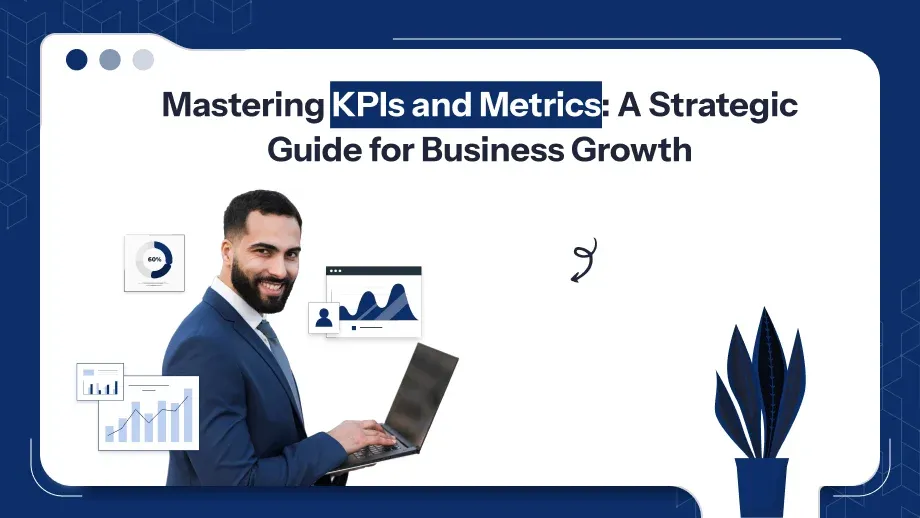
Introduction
It can now measure performance effectively in the fast-paced competitive business world today. Organizations use KPIs and metrics to monitor the level of progression, align goals in their setup, and make informed decisions. But what are KPIs and metrics, and why are they such a big deal?
This blog delves into the meaning of KPIs (Key Performance Indicators) and metrics, their differences, and their crucial role in driving organizational success. We’ll also explore how businesses can leverage these tools to optimize performance and achieve their goals.
What Are KPIs?
KPIs or key performance indicators are measurable quantities that indicate the level of accomplishment of an organization in attaining its strategic goals. They give a high-level view of performance and make businesses focus on what really matters.
Characteristics of Effective KPIs:
- Specific: Clearly defined and aligned with business goals.
- Measurable: Quantifiable with reliable data.
- Achievable: Realistic and attainable.
- Relevant: Linked to key business objectives.
- Time-Bound: Defined within a specific timeframe.
Examples of Company KPIs:
- Sales KPIs: Revenue growth, customer acquisition rate.
- KPI in Marketing: Conversion rate, cost per lead.
- KPI in HR: Employee turnover rate, average time to hire.
- Operations KPIs: On-time delivery rate, production efficiency.
For HR professionals, KPIs such as those found in HR manager KRA and KPI frameworks are instrumental in tracking the effectiveness of HR strategies.
What Are Metrics?
Metrics are data points that measure specific business performance aspects. Although they play a crucial role in monitoring operations, metrics are usually more detailed and tactical than KPIs.
Characteristics of Metrics:
- Granular: Focused on specific processes or activities.
- Supportive: Provide data to track progress toward KPIs.
- Flexible: This can change based on the area being measured.
Examples of Metrics:
- Website Metrics: Page views, bounce rate.
- Customer Service Metrics: Average reaction time, score of customer satisfaction.
- Financial metrics: Gross profit margin, EBITDA.
Difference Between KPI and Metrics
While KPIs and metrics have a lot in common, however, they are used for different reasons. Understanding the differentiating factors between the two is crucial for successful measurement performance management tool.
| Aspect |
KPIs |
Metrics |
| Purpose |
Strategic focus |
Tactical details |
| Impact |
Measures overall success |
Tracks individual processes |
| Scope |
Aligned with business objectives |
Supports KPIs with detailed data |
| Examples |
Revenue growth, employee retention |
Daily website traffic, defect rates |
KPI vs Metric: A Clear Analogy
Imagine the KPI to be a destination on the map. The signposts and the landmarks that show the direction will be the metrics. While it is equally essential, each fulfills a slightly different role when helping to get you to the final destination.
Ready to elevate your business with strategic KPIs and metrics?
Start leveraging actionable insights to achieve measurable success today!
Why KPIs and Metrics are the Backbone of Business
KPIs and metrics form the backbone of any data-driven business strategy. They help keep businesses on track in terms of objectives while continuously improving their performance. Here are the key reasons why KPIs & metrics are essential:
Align Goals Across Teams
KPIs ensure that every department within an organization is working toward common strategic objectives. By clearly defining and communicating these indicators, businesses can:
- Foster collaboration across teams.
- Avoid duplication of efforts or misaligned priorities.
- Create a shared sense of purpose.
For instance, HR KPIs aligned with organizational objectives can be tracked using tools like an HR database, ensuring seamless integration of employee goals with business strategies.
Monitor Progress Toward Objectives
KPIs and metrics give a clear view of how well an organization is performing relative to its goals. They allow for:
- Timely identification of areas that require corrective action.
- Tracking of progress over time, enabling teams to stay on course.
Enable Data-Driven Decision-Making
Proper leveraging of accurate data through KPIs and metrics by decision-makers allows them to:
- Prioritize their resources as much as there is a demand for them.
- Create strategies aligned to real-time findings.
- Anticipate future challenges and opportunities.
Enhance Accountability
When a company clearly establishes KPIs & metrics, its teams, and individuals assume more responsibility regarding them. This becomes a culture in the organization when the employees acknowledge that they hold part of organizational success.
Steps for Selecting Appropriate KPIs and Metrics
The right selection of KPIs and metrics is most important in relation to the meaningful measurement of performance; with the effective use of HR software in India, businesses can readily align the indications with the corresponding organizational goals involving the right sets of stakeholders and focus on actionable inputs. Here’s a detailed guideline to optimize tracking and decision-making.
Understand Your Business Objectives
Begin with the identification of the top-level goals of your organization. These may include increasing revenue and improving customer satisfaction, streamlining operations, or enhancing employee engagement. Your KPIs should reflect these objectives directly.
Involve Key Stakeholders
Collaboration is essential for selecting KPIs & metrics that resonate across the organization. Include stakeholders from different departments to:
- Gain a comprehensive understanding of business priorities.
- Ensure that KPIs are relevant to all teams.
- Foster buy-in and commitment to achieving these indicators.
Focus on Actionable Indicators
Avoid vanity metrics that may look impressive but don’t provide actionable insights. For example:
- Instead of focusing on the number of people visiting your website, track the conversion rate of your site, meaning how well it is converting to sales.
- In the HR department, instead of tracking applicants, quality hires are important.
Set Clear Targets and Baselines
Before you can measure progress, you need a starting point (baseline) and a clear goal (target). For example:
- Benchmark: The present customer retention rate is 85%.
- Target: Retain 90% after six months.
Choose a Balanced Mix
Ensure your KPIs & metrics cover various aspects of your business. A balanced scorecard approach can be helpful, focusing on:
- Financial: Revenue, profit margins.
- Customer: Satisfaction scores, Net Promoter Score (NPS).
- Internal Processes: Efficiency metrics, defect rates.
- Learning and Growth: Employee engagement, training completion rates.
Best Practices in Tracking KPIs and Metrics
The effective tracking of KPIs & metrics makes them relevant and useful even after some time. Here are some best practices:
Use Dashboards and Visualization Tools
Visualize the data using Tableau, Power BI, and Google Analytics, hence making the decisions faster.
Review Regularly
Set up regular review intervals to ensure your KPIs remain aligned with business goals.
Ensure Data Accuracy
Accurate data collection is critical for reliable performance measurement.
Provide Transparency
Share the KPI performance with the concerned teams to encourage a culture of accountability and collaboration.
Common Challenges and How to Overcome Them
Despite their importance, tracking KPIs and metrics comes with challenges:
1. Misaligned KPIs:
Ensure KPIs are linked to overarching business goals.
2. Overloading with Data:
Track only a few meaningful KPIs instead of too many metrics.
3. Lack of Data Literacy:
Train employees to understand and utilize performance data effectively.
4. Resistance to Change:
Focus on the benefits of data-driven decision-making and gain the buy-in of the team.
Metrics of Measurement vs. Metrics of Success
Metrics of Measurement are tactical and focus on individual activities, such as the number of emails sent in a marketing campaign. In contrast, Metrics of Success reflect the outcomes of those activities, such as the conversion rate achieved.
For example:
- Measurement Metric: Number of visitors to a website.
- Success Metric: The percentage of customers who have completed an order.
Leveraging KPIs and Metrics with HR Technology
The latest HR technology, including the top HRMS software streamlines the tracking of metrics. These technologies bring real-time data, make reporting easier, and improve decision-making.
Examples:
1. Best HR Software:
Tracks employee turnover and engagement levels.
2. HR Training:
Monitors HR training effectiveness through metrics like knowledge retention scores.
With the integration of advanced HR technology, organizations can align their HR KPIs with the business goals, and this will be a more agile and responsive workforce.
The Future of KPIs and Metrics
Technology is changing the possibilities for KPIs and metrics. The most important trends that will shape the future of HR comprise:
1. Real-Time Analytics:
Organizations will depend on real-time data to make faster, more informed decisions.
2. Predictive Analytics:
Advanced tools will use historical data to predict future performance trends.
3. ESG Metrics:
Environmental, Social, and Governance metrics will become integral to measuring organizational success.
4. AI Integration:
Data collection and analysis will be automated with AI-powered tools, thus saving manual effort and reducing errors.
Conclusion
KPIs and metrics drive business success in today’s data-driven world. Understanding the differences between them and using them effectively helps organizations achieve strategic alignment, monitor progress, and make informed decisions.
This involves choosing pertinent metrics, a toolset that is quite correct, and developing an accountability culture. With HRMS payroll software in India, capabilities, businesses may simplify performance measurements and report automation to attain accurate key performance measurements. Start defining and tracking your KPIs today to unlock the full potential of your business—the future of success lies in the data.






